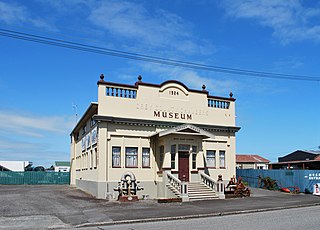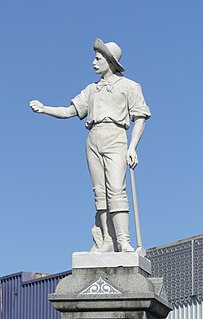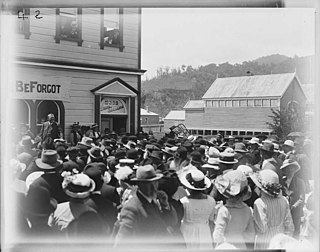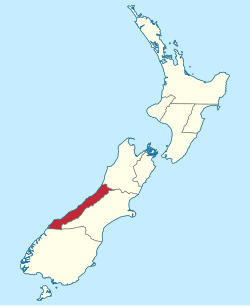
The Taramakau River is a river of the West Coast Region of the South Island of New Zealand. It rises in the Southern Alps / Kā Tiritiri o te Moana near Harper Pass, 80 kilometres (50 mi) due east of Hokitika, and runs westward for 75 kilometres (47 mi) into the Tasman Sea 15 kilometres (9.3 mi) south of Greymouth.

Westland District is a territorial authority on the West Coast of New Zealand's South Island. It is administered by the Westland District Council. The district's population is 8,910.

Nelson Province was constituted in 1853 under the New Zealand Constitution Act 1852, and originally covered the entire upper South Island, including all of present-day Buller, Kaikoura, Marlborough, and Tasman districts, along with Nelson City, Grey District north of the Grey River, and the Hurunui District north of the Hurunui River. It was reduced in size by the creation of Marlborough Province in November 1859, then abolished in 1876, along with all the provinces of New Zealand.

The Westland Province was a province of New Zealand from 1873 until the abolition of provincial government in 1876. The capital was Hokitika.

Richard Harman Jeffares Reeves was a New Zealand politician of the Liberal Party. He was acting Speaker of the Legislative Council in 1905.
Kumara was a parliamentary electorate in the West Coast region of New Zealand, from 1881 to 1890.
Westland Boroughs was a parliamentary electorate in the West Coast of New Zealand from 1866 to 1870.

Charles Edward Button was a solicitor, Supreme Court judge, Mayor of Hokitika and later Birkenhead, and an independent conservative Member of Parliament in New Zealand. Born in Tasmania, he came to New Zealand with his wife in 1863. He first lived in Invercargill, then in Westland, and after a brief period in Christchurch, he settled in Auckland. He was an MP for two periods, and when he was first elected to Parliament, he beat his colleague, friend, political opponent and later Premier Richard Seddon; this was the only election defeat ever suffered by Seddon.
William Henry Harrison was a 19th-century journalist from Greymouth who represented two Westland electorates in the New Zealand House of Representatives.
Edmund Barff was a 19th-century Member of Parliament from the West Coast, New Zealand.
John Bevan was a 19th-century member of the House of Representatives. He was a auctioneer and merchant from Hokitika on the West Coast of New Zealand.
Robert Caldwell Reid was a 19th-century Member of Parliament from the West Coast, New Zealand. Born in Scotland and attracted by the gold rushes in Victoria and the West Coast, he was later the proprietor of a series of newspapers.
John White was a 19th-century member of the House of Representatives from the West Coast, New Zealand.

Grey County was one of the counties of New Zealand in the South Island.
The Westland Boroughs by-election 1868 was a by-election held in the Westland Boroughs electorate during the 4th New Zealand Parliament, on 3 April 1868.
Henry Hermann Lahmann, also known as Henry Herman Lahman and often referred to as H. H. Lahman, was a German immigrant who became a politician on the West Coast of New Zealand. He was active in provincial politics and was later appointed to the Legislative Council (1872–1890).
The Mayor of Grey, often referred to as the Mayor of Greymouth, officiates over the Grey District of New Zealand which is administered by the Grey District Council with its seat in Greymouth. The current Mayor is Tania Gibson. Two predecessors to this office were the Mayor of Greymouth, officiating over the Greymouth Borough Council from 1868, and from 1877 the chairman of the Grey County Council.

The Hokitika Borough was the borough council covering the urban part of the town of Hokitika, New Zealand between 1867 and 1989, when Hokitika Borough and Westland County merged to form Westland District.

The Westland Pioneers' Memorial is a statue in Hokitika, New Zealand, commemorating the pioneer settlers of Westland. Unveiled in 1914, the statue had its right arm broken off in 2009 and was subsequently been dubbed Venus de Hokitika. The memorial was relocated in 2016 from its original location on the side of State Highway 6 to the centre of a roundabout in one of Hokitika's main streets.

The Ross Borough was the borough council covering the town of Ross, New Zealand and the nearby locality Donoghues, between 1878 and 1972, when Ross Borough was merged back into Westland County.












